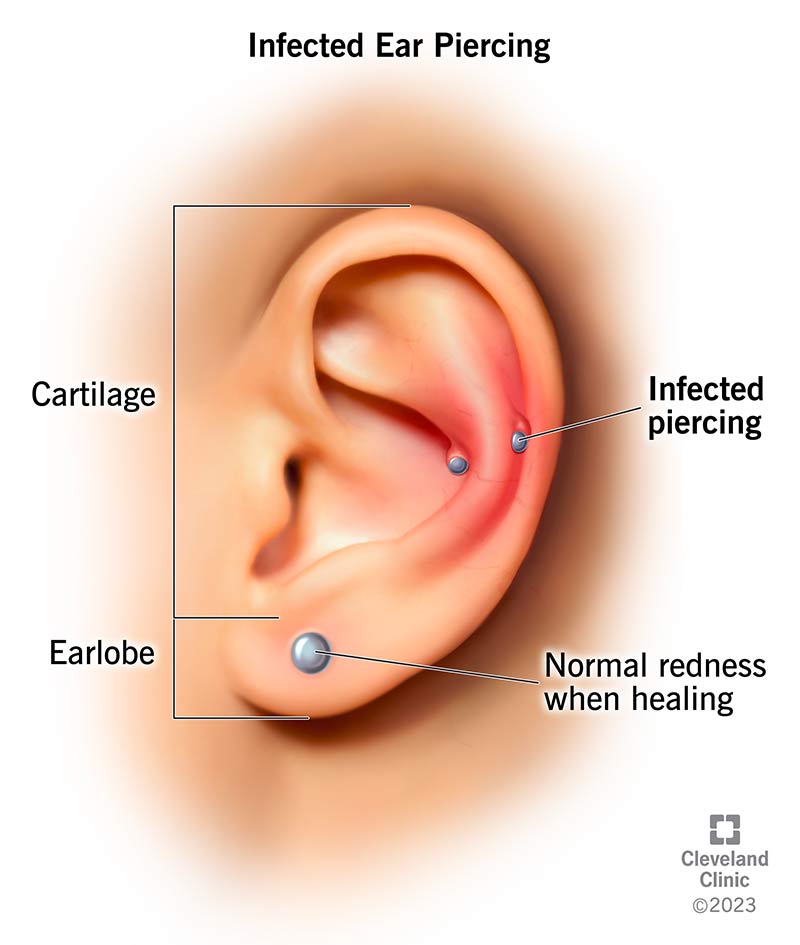A new ear piercing is an open wound that can take several weeks to fully heal. During that time, any bacteria that enter the wound can lead to infection. Taking good care of your piercing is key to preventing infection.

An ear piercing is a hole through your earlobe or the cartilage in your middle or upper ear. Ear piercing infections may be red, swollen, sore, warm, itchy or tender. Sometimes, piercings ooze blood or white, yellow or green pus.
A new piercing is an open wound that can take several weeks to fully heal. During that time, any bacteria that enter the wound can lead to infection.
The two main types of ear piercings are through your earlobes and through the cartilage of your ear.
Your earlobes are fleshy and fatty, with strong blood flow. They heal quickly, reducing the risk of an infected earlobe piercing.
Your upper ear is cartilage, a thick, stiff tissue with less blood flow. Piercings in your upper ear are more likely to become infected, and infections in your upper ear are sometimes serious.
Millions of people get their ears pierced every year, and most of them have no serious complications. Mild irritation and infections are common, however, for new piercings. In most cases, infections aren’t serious and clear up quickly.
In one study, as many as 35% of people with pierced ears had one or more of the following complications:
Advertisement
Cleveland Clinic is a non-profit academic medical center. Advertising on our site helps support our mission. We do not endorse non-Cleveland Clinic products or services. Policy
Some pain and redness are part of the normal healing process for pierced ears. It can be easy to confuse those with signs of infection.
If there’s a bump on the back of the ear piercing, it’s not necessarily infected. Small bumps called granulomas can sometimes form around the piercing. These bumps are trapped fluid that you can treat by compressing them with warm water.
You know your ear piercing is infected if you have symptoms such as:
If bacteria get into a new piercing, it can lead to infection. You may expose your new piercing to harmful bacteria by:
Many things can increase your risk of getting an infection from an ear piercing. Certain health conditions can affect your body’s immune system and your ability to fight infection. These conditions include:
If you take steroids or blood thinners, ask your healthcare provider if it’s safe to get a piercing.
Advertisement
Leaving an infected piercing untreated can result in a more severe infection or an abscess (a swollen area filled with pus).
Upper ear piercings are more likely to get infected. Left untreated, these infections can lead to a condition known as perichondritis. An infection can also spread into your body (systemic infection).
In some cases, an infection can cause your piercing to close up.
If you see signs of an infected cartilage piercing, you should contact a healthcare provider. The provider can assess the severity of the infection.
If you suspect an infection in an earlobe piercing, take special care with hygiene. If the infection worsens, contact a provider.
Advertisement
A healthcare provider can tell you what to do for an infected ear piercing. They may recommend a variety of treatments to help heal an infected ear piercing. Ear piercing infection treatment may include:
Taking good care of your piercings is key to preventing infection. You should:
With good care, most infections clear up within a few days. If your infected ear piercing isn’t improving, you should see a healthcare provider.
You should call a healthcare provider if you experience:
You may want to ask your healthcare provider:
A note from Cleveland Clinic
Getting your ears pierced is most often a safe, simple procedure. Be sure to go to an experienced piercer who practices proper hygiene. Keep your new piercings clean, and don’t remove your earrings until your piercings have healed completely. Be patient — by preventing an infection now, you can enjoy your healthy piercings for years to come.
Last reviewed on 04/05/2023.
Learn more about the Health Library and our editorial process.
Advertisement
Cleveland Clinic is a non-profit academic medical center. Advertising on our site helps support our mission. We do not endorse non-Cleveland Clinic products or services. Policy